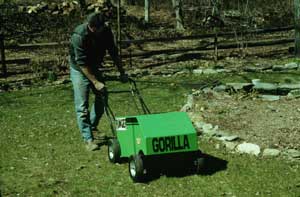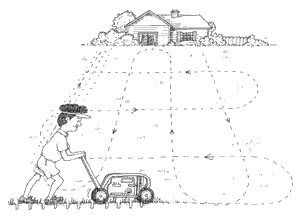Choose Your Weapons
If your lawn is 6000 square feet or smaller, a hand lawn aerator tool is fine for the job. Rather than aerate the whole lawn in one day, do it in sections over several weekends. Use the hand tool to aerate hard to reach places such as along edges of walks, between stepping stones or near fragile tree roots. A hand tool is inexpensive and gives you some aerobic benefit too.
 |
Use a power-driven lawn core aerating machine for a lawn much larger than 6000 square feet. They rent for about $50 to $75 a day, more if delivered and picked up. Because they work like a power lawnmower, you can cover a lot of ground fairly quickly, with time left over for your neighbor to use the machine too. Estimate about two hours for a quarter acre of lawn.
When to Aerate
Fall is the best time to aerate, because the grass is shifting its attention from blade growth to root growth. Providing oxygen and loosening the soil at this time really stimulates strong root development. If the fall is inconvenient spring is the next best time to aerate. Wait until the soil has dried out from spring rains, though.
Do not aerate in the summer. Grass plants are at peak growth, possibly coping with heat and reduced moisture as well, so they will be badly stressed by aeration. If you are using a hand aerating tool, you can do half the lawn in the spring and the other half in the fall with great results.
Good Aerating Technique
 |
Hand lawn aerators are helpful even though you rent a power one. Use them for narrow areas near walks, drives and patios and, especially under trees. Always aerate around trees with a hand aerator, at least out to the dripline and a little beyond, to avoid damaging their roots.
How Often to Aerate
The benefits of aeration are tied to the benefits of topdressing/mulching the lawn with some kind of organic material such as finely chopped leaves or peat moss. If you topdress the lawn faithfully each fall, then aeration is most important in the first year or two. After that, aerate only every few years.
If you do not topdress or mulch your lawn, then you might want to consider aerating annually for two or three years to overcome the accumulated effects of years of compaction. Once it is somewhat reduced, core aeration once every three or four years is sufficient to maintain the level of improvement. Remember, thatch buildup tends to occur in three to five year cycles, so aerating the lawn at those intervals will probably control most thatch build up too.
Aerating by Topdressing with Mulched Leaves
Use a mulching type lawnmower to create a ½ inch layer of finely chopped leaves on the lawn at the end of the season. Earthworms pull down these leaves into the soil where they become food for the microbial population whose activity breaks up compacted soils. Topdress with a layer of Canadian sphagnum peat moss or other organic material if you do not have trees on your property or access to leaves. If you do not ever topdress your lawn, aeration is your only technique for fighting compaction.
However, combining topdressing with aeration in the fall combats soil compaction even than either technique alone. Do either job first, though it is usually convenient to aerate first and then mulch within a week. This breaks up the cores and leaves lots of leaf particles right down in the core holes ready for the bacteria to start their work.
Spiking the Lawn
Another mechanical way to introduce oxygen into compressed soil and to loosen it is spiking. While not as effective as core aerating, spiking mitigates compaction problems, even as they develop. It prevents dirt paths in your lawn where there is frequent foot traffic. Professional golf course maintenance supervisors know this. They spike the most heavily trod parts of the golf course regularly, often weekly.
Hand or powered spiking equipment does not remove cores from the soil. Their 3 or 4 inch pointed metal spikes simply make lots of small punctures instead. (The spikes on golf shoes are not long enough to do the job). Often a little spiking is enough to keep the soil from getting too compacted where the mailman cuts across the yard, where kids take a shortcut to the neighbor's house or where you walk to put the trash out. While there are power spiking machines, hand spiking tools make the most sense for residential yards. They are portable and handy, so it is easy to duck out and routinely spike the problem areas every two or three weeks throughout the growing season.

